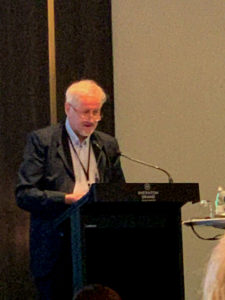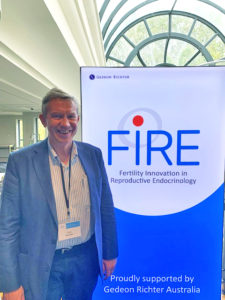Dr Terry Sheahan recently attended the Fertility Innovation in Reproductive Endocrinology conference held in Sydney on 22nd February 2020. Among the host of outstanding international speakers, he had the opportunity to speak at length with Professor Ole Christiansen.

Professor Christiansen is a world leader in the management of recurrent miscarriages. He resides in Aalborg near Copenhagen where Joen Utzon’s last major building still stands. Utzon was the architect who designed the Sydney Opera House, and Professor Christiansen was pleased to hear Dr Sheahan confirm that the Opera House interior is currently being restored according to Joen Utzon’s original design.
Dr Sheahan and Professor Christiansen had a vigorous discussion about modalities Danish reproductive experts are using that are resulting in considerable success. These include intravenous immunoglobulin and the use of steroids and progesterone in IVF cycles. Positive outcomes have been achieved including a pregnancy rate of 34 to 70 percent in the first treatment cycle, with a cumulative live birth rate of 67 to 78 percent in women who had up to three previous pregnancy losses.
Screening for hereditary diseases before pregnancy
In Australia, the Royal Australian and New Zealand College of Obstetricians and Gynaecologists (RANZCOG) currently recommends that all women contemplating a pregnancy should be offered screening for hereditary diseases.

Cystic fibrosis, spinal muscular atrophy and fragile X syndrome are all conditions worth screening for. This is because you can be a carrier for a disorder but not show any signs or symptoms. If you have a child with a partner who is also a carrier, you may have a one in four chance of having a baby with these types of conditions, including cystic fibrosis.
Typically during pregnancy, most women are screened for a variety of conditions that may affect their baby, including Down syndrome and other chromosomal disorders. Techniques such as non-invasive prenatal testing (NIPT) or nuchal translucency screening are other methods thatcan be used to check the health of an unborn baby. Many conditions can also be identified via ultrasound with an early anatomy scan or more importantly, an 18 to 20-week morphology scan.
For those after more information about other genetic disorders they may be carrying, there is also a test that uses ‘next generation sequencing’ which can detect over 500 conditions. However, it can be an expensive exercise -costing up to $700 per patient and over $1000 per couple.
However, a variety of screening measures both before and during pregnancy are readily available and I highly encourage you to consider this if you are pregnant or contemplating a baby.
If you would like to find out more information about these tests, book an appointment with Dr Terry Sheahan on (07) 3353 3100.
